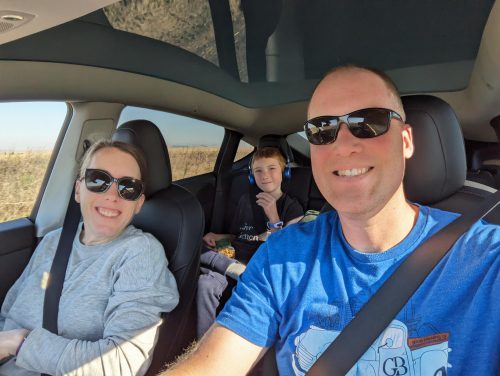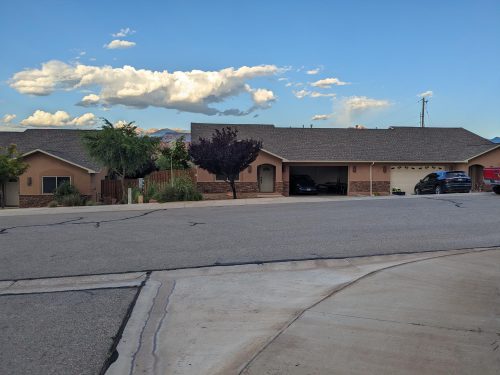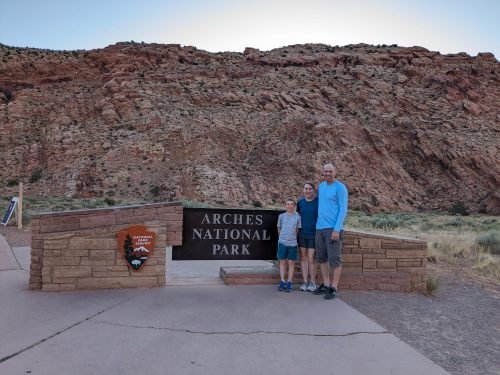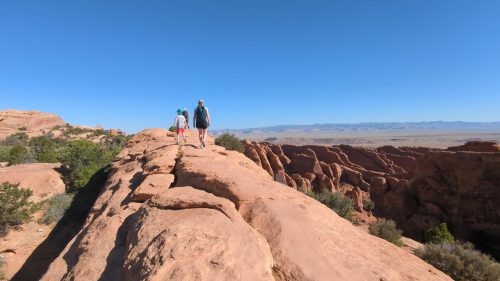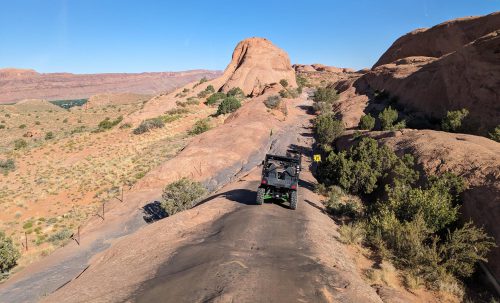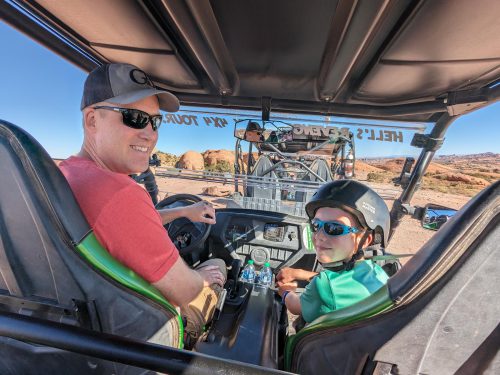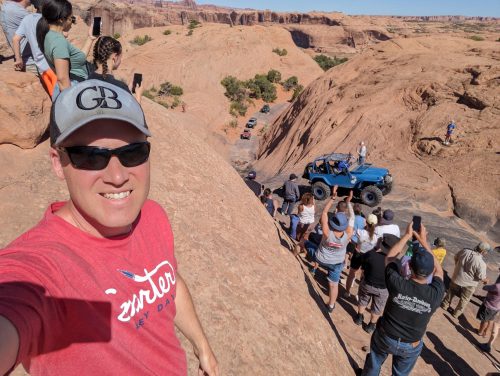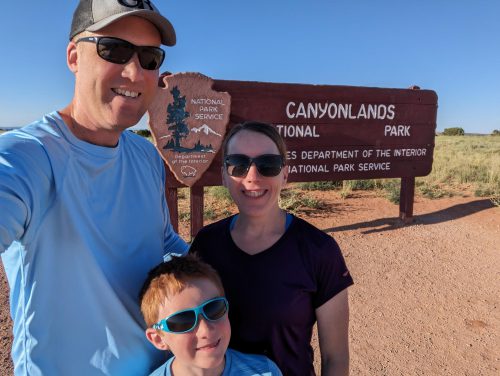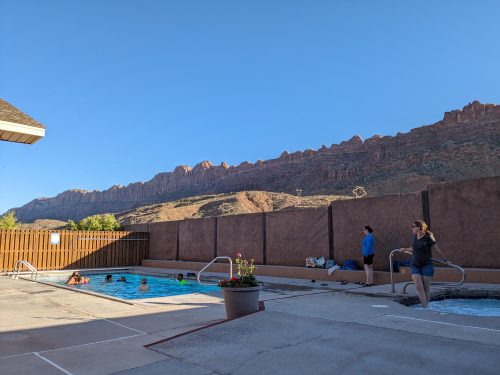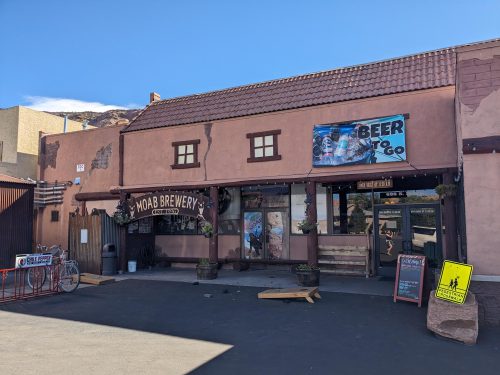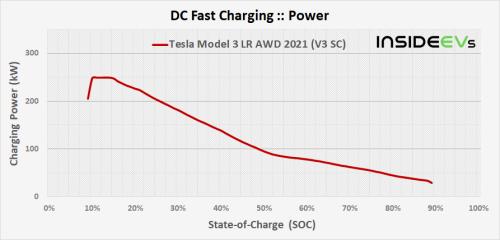The previous post contains a lot of detail about our trip but I edited together some video from the trip too.
One Week in Moab
This year, we decided to visit some of the national parks in southern Utah for our family vacation. It started as an idea to hit all five, but we scaled back to spending a week in Moab, Utah for easy access to two of the parks. In the end, we were glad we simplified our plan because there was a lot to keep us busy and it was more relaxing than trying to cram in a bunch of different stops.
Moab is about 1100 miles from our house, and I’ll write a detailed post about our road trip, but in short, we took two days to drive down there and two days back. So after two long days in the car, we rolled into Moab late on Sunday afternoon.
I’m happy to promote the Airbnb that we rented. It was a duplex so we had our own garage (with a charger for our electric car) along with way more beds than we needed. It also had a private hot tub along with a full washer and dryer. There was a community pool a short walk away too. It was a great home base for our adventures.
I had tried to pre-plan as much of the trip as possible so that I wouldn’t have to be doing logistics and figuring things out while I was on vacation. Plus, Moab is an incredibly busy place and many of the things we wanted to do required reservations months in advance. Moab is a town of about 5000 people with around 2 million people who visit every year! The economy is defined by tourism which is good for business but it’s also wreaking havoc on the people who live there. They simultaneously can’t make a living without the tourists and they often can’t afford basic necessities like housing because of the tourists.
Monday
For our first full day in Moab, we started with Arches National Park which is just on the north end of town. It was about a 15 minute drive from our house. Arches is using timed entry reservations. Months in advance, I registered for entry into the park between 7am and 8am on the day we were planning to go in. We arrived right at 7am in hopes of beating the crowds a bit and also beating the heat. Our plan each day was to be mostly done with planned activities by noon to avoid the hottest part of the day and leave ~half the day open for random activities. This meant getting up early each morning on vacation, but I think we’d do it the same way if we went back.
I have seen plenty of pictures of some of the arches in the park, but I was surprised how different it felt to be there in person. A picture can’t communicate the enormity of the scenery. It feels like the opposite of a green, cool place like Seattle!
We came prepared with an itinerary for our park days thanks to dirtinmyshoes.com. For a few bucks, I purchased her guide to Arches and we followed her two day itinerary. I won’t repeat the details here since I don’t want to give a free summary of her great content, but we were very happy with the info she provided! Despite the extreme visitor load, we never found a trailhead that was full, we ate lunch in a completely empty picnic area each day, and we even had some of the arch views to ourselves!
The highlight of our first day in the park was the Devil’s Garden area. Landscape Arch is enormous and the hike from there to the Double O arch was one of our favorite hikes of the trip. It required climbing up and walking along big rock fins.
Tuesday
Tuesday was our first of two paid adventures: off roading! Moab is a world-renowned mecca for offroad fun and we didn’t want to miss the opportunity. We chose a 2.5 hour with the cleverly named “Moab Tourism Center” tour company. I drove the UTV/side-by-side for our family and there were a total of 5 vehicles in our group including our guide.
It’s hard to put into words what this trip was like! The vehicles were extremely capable and the terrain was incredible. We drove up steep narrow fins, down steep inclines, and over all sorts of terrain that I would never have imagined was possible.
A huge portion of Utah is “BLM land” (Bureau of Land Management) and you can do pretty much anything you want there. Our tour took us through the “Hell’s Revenge” area which had a additional rules because of the high traffic. If you’ve watched any rock crawling videos on the internet, you’ve probably seen some of the main features in this area. We stopped at “Hell’s Gate” and watched four vehicles try to climb it. Three made it up fine but the fourth flipped up and over! Everyone was fine, but it was quite a sight. All of this is just a short drive out of town so part of our tour involved a ~10 minute UTV drive on the roads to and from the business where we started. UTVs can be road legal in Moab and you see lots of them!
If I could go back for one day, I’d do another UTV trip!
Wednesday
We got up early again to get into Arches right at 7am since it had been working so well for us the previous two days. This day involved more highly trafficked parts of the park, but our early start gave us easy parking and ok-ish crowds. Highlights were Delicate Arch, both of The Windows, and the Double Arch. When I had been researching this trip, I saw Double Arch and immediately recognized it as from the opening scenes of Indiana Jones and the Last Crusade. While the arch was covered in people, it was still neat to see the area in person. We again ate lunch at a completely empty picnic area with a great view of Balanced Rock.
Thursday
Our second scheduled excursion was a half day rafting trip from Adrift Adventures. Their web presence and signup process was less polished than our other excursion, but everything went smoothly. There were three small groups like ours that got put together in one boat and then there was an enormous group of dads and sons that filled up about four or five other boats. They were pretty wild so our guides did a good job of keeping us separated from them on the river so we could have our own fun.
The trip mostly hits “bumpy water” Class 1 and 2 rapids but there was one short Class 3 section too. This felt just about right for our family. There were a couple areas where Tyla and I both jumped out of the boat to swim, and Elijah even got to row the boat for a while.
The river had about 2.5 times as much water flowing through it as it did last year so everything was moving faster than normal. We got to do the whole 12-mile stretch that they normally divide up into two different 6-mile tours.
Friday
For our last day in the parks, we drove about 50 minutes to Canyonlands National Park. This park is divided into three distinct areas and the entrances are hours apart. We chose the Island in the Sky district. The name comes from the fact that this part of the park is mostly on top of a large mesa.
The site we used for he Arches Itinerary had some guidance for Canyonlands but not a full itinerary, but our early arrival paid off again and we were able to see everything without overwhelming crowds. Our first stop was Mesa Arch and it might have been our favorite one of the trip! It’s quite a trippy experience walking up to the arch because it’s right on the edge of the mesa so there’s an enormous drop off beyond the arch. We also had the whole thing to ourselves for quite a while so we got some good pictures and enjoyed the view.
We did one longer hike out to Murphy Point and thoroughly enjoyed the view there. Again, we had the whole viewpoint to ourselves for almost the whole time!
The remaining stops were a couple that we could drive to which mean that they were much busier, and while the views were awesome, our first two private stops were much more enjoyable due to lesser crowds. We found another private picnic spot with shade and a great view for lunch.
Miscellaneous
Our plan to finish each day around 12 or 1 worked out well. We got to beat the heat and crowds, and we also had the afternoon free for relaxing and spending time in the community pool.
We saved a lot of time and money by eating breakfast and lunch at the house every day (or packing a picnic lunch.) We did go out to dinner each night and our favorite spots were the Moab Brewery, El Tapatio, Moab Food Truck Park, and Spitfire Smokehouse. Utah has some confusing liquor laws which means that good draft beer is hard to find, but I did sample quite a few new ones.
We played the license plate game on our drive and made it amazingly close to collecting them all! We ended without seeing Hawaii, Rhode Island, and Delaware, but we did get a few Canadian provinces, D.C., and two Mexican states (Chihuahua and Nuevo Leon.)
Summary
This is long post already, but we have so many memories that I haven’t touched on here like lizards, base jumpers, frisbee plates, the Tree Penguins, the filming location for Horizon, meeting people from Woodinville on our first day in Moab, Lops ice cream, and a lot more. What an amazing trip!
I did a lot of research and planning ahead of time, fully expecting to only use it as a rough guide, but almost the entire trip went flawlessly according to plan. The return trip had some hiccups mostly due to extra traffic on the weekend before the Fourth of July, but it wasn’t a big deal. I’m so thankful for the smooth adventure and the fun family memories. When’s our next road trip?! Let’s do it again!
Tesla Charging Curve
Welcome to another Tesla Tuesday!
We are back from a 2500-mile road trip with our Model Y. I was collecting data from the whole trip, and I have a couple more posts coming to detail the experience, but while I work on that, I want to start by devoting an entire post to explaining the charging curve of a Tesla.
The key point here is that when you are supercharging, the speed of your charging depends on how full your battery is. The battery can be charged much faster from 10% to 30% than from 70%-90%.
The above chart shows the curve for a 250kW charger. Most superchargers are 150kW max output, but newer ones are 250kW. (A few of them are 70kW but those are rare.) For a 150kW charger, imagine the same curve but it is capped at 150kW. So it’s slower at first, but by the time you hit ~40% charge, the two chargers give you the same speed (…usually. More on this later.)
Imagine you could fill your gas tank faster the emptier it was. You’d only want to put in as much gas as you needed to get to your next fueling stop. So whichever speed you’re using to charge, the key takeaway is that if you’re trying to spend the least amount of time possible at a charger, you want to start at around 10-15% and charge as little as you need to get to the next charger.
This becomes important if you’re trying to optimize the charging stops on a long road trip. There’s a tradeoff between getting enough juice to skip over a charging stop and the slower charging speeds you that give you that extra juice. Thankfully, you don’t have to think about this as most EV trip planners (including the one built into Teslas) take this into account automatically.
Here’s a chart from all the supercharges we’ve done on our Model Y:
Click to open that in a new tab. You should see three basic curves. The top one is 250kW chargers, the second one is 150kW chargers, and the bottom one is from one use of a 70kW charger, but mostly it’s from lower output at a 150kW charger. This is because the older 150kW superchargers are paired. When you pull up to a charger, the stalls are labeled 1A, 1B, 2A, 2B, etc. If you are sharing an A/B with another car, you split the 150kW. As a supercharger gets busier, this means it takes longer to charge causing longer waits to for people to get a stall. Obviously this isn’t ideal so the newer 250kW chargers are all isolated. No matter how busy the charger is, you’ll get the full firehose of electrons shooting into your car.
If this sounds complicated, I assure you that you can happily drive an EV without knowing any of this. In fact, it’s obvious that a lot of Tesla owners are clueless to the differences between chargers and the pairing of the 150kW chargers. I love this stuff and I want to be as efficient as possible so I geek out with all this data. And if you think this was geeky, wait until I detail how I planned our trip in a future post!
Disc Golf
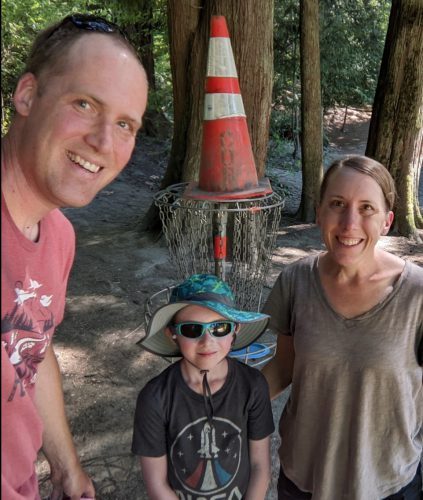
When I started playing disc golf towards the end of last summer, I started learning that I was right in the middle of a big surge of interest in the sport. It really spiked when COVID hit and the interest has continued. UDisc is the most popular app for tracking scores and finding courses. They have an annual report about the growth of the sport if you’re interested in stats.
It’s been a big hit in our house because it’s something that all three of us can enjoy, and it’s generally free. UDisc says that 90% of all disc golf courses are free to play. You can get a starter set of three discs for about $30 and I used my starter set for a very long time before buying some specific, fancier discs for $15-20/each.
I’m writing this post because I realized there have only be a couple blog posts that mention disc golf. Considering how much I have been playing, that feels a bit off, so I thought I’d use this post to answer some of the questions I had as I got into it:
Where do you play? There are courses at lots of local parks. UDisc says that 28% of Americans live within 2 miles of a course and 88% are within 10 miles. You can find them by going to https://udisc.com/courses or searching on internet maps. I’m lucky to live near a great course at Blyth Park in Bothell.
It seems intimidating. How do I not look like a moron? This is the biggest thing that held me back from playing. I regret the time I lost worrying about this. Disc golfers are generally super friendly! With so many people joining the sport, you’re probably not the only newbie out there. If you don’t know what to do, find somebody else who is playing and just ask them. Or if you look confused, someone will probably offer to help.
What do you do? When you get to the course, find the first tee. Sometimes there’s a map showing all the holes. Or if you have the UDisc app, it will show you a map of the course with your current location noted. That app is really helpful as you go from hole to hole looking for the next tee. Once you’ve found the first tee (usually some kind of a concrete or dirt pad about 2 feet by 6 feet), throw your first shot. Walk up to your disc, make sure one foot is right behind where your disc landed, and throw your next shot. Eventually you’ll make it to the basket and your disc must end up in the basket. Count your strokes and move on to the next tee.
How long does it take? My local course has 10 holes. (9 and 18 hole courses are the most common but it’s not super rare to have a different number of holes.) I can play a round by myself in 30-40 minutes, but obviously if there’s a lot of traffic on the course that can slow things down a bit.
What is the etiquette? If you’ve ever played traditional ball golf, a lot of etiquette is very similar. Some general guidelines are:
- Wait until the people in front of you are out of range before you throw. Generally this means waiting until they’re done with the hole.
- Yell “Fore!” if your disc is heading toward someone else.
- Whoever is farthest from the hole throws next.
- Play “ready golf” by knowing which disc you’re going to use and being ready to throw when it is your turn.
- Be aware of people throwing on holes near you. Disc golf courses can be tight and it’s easy for errant shots to veer into neighboring holes.
What’s the difference between a disc golf course and a traditional/ball golf course? While both have “tees” and “fairways” and conceptually are similar, the physical appearance can differ in a few ways:
- Disc golf holes are shorter. Most holes will range between 200-350 feet if they are beginner-friendly while long/pro holes can stretch over 1000 feet in some extreme cases.
- Disc golf courses have a lot more variety. Courses might be set in thick woods, an open field, zig zagging across an old golf course, etc.
- Disc golf courses make a lot more use of natural terrain and obstacles and some will even include man-made obstacles like a tall fence stationed at a key point in the middle of the fairway to make the hole more interesting.
- Some disc golf holes include a “mando” (short for “mandatory”) which means that you must go to the right or left of a specific obstacle.
- There’s no “green” for disc golf. There’s an imaginary circle around the basket with a radius of 30 feet and there are slightly special rules in that zone, but generally this isn’t explicitly marked.
Why do my discs always go to the left? Because of the physics of a disc, most discs will curve to the left, especially at the end of their flight. As people get better and can put more speed and spin into the disc, they can have different flight characteristics depending on the disc. As a beginner, I just plan for the curve.
Do discs get lost? Yes. Most people write their name and phone number on the back of the disc and people are pretty good about calling or texting if they find your disc. Thankfully I haven’t lost a disc yet, but I’ve probably spent more time than is reasonable looking for lost discs. Losing a disc isn’t as common as losing a golf ball though which is good because people get more attached to their discs as they learn how each specific disc flies.
What are some good sources for learning? I subscribe to quite a few disc golf channels on YouTube. Here are three of my favorites. All of these have a lot of videos so click on their playlists section to zero in on content that interests you.
- Robbie C Disc Golf – Robbie has a lot of beginner friendly videos and always focuses on mechanics that are helpful to average players.
- Overthrow Disc Golf – Josh was a full time professional tennis coach before switching primarily to teach disc golf. He is excellent at breaking down body mechanics into simple steps.
- Foundation Disc Golf – Foundation is mainly an online store that sells discs, but they have a fun YouTube channel as well. There is a ton of content of them playing rounds with various tweaks to the rules (like only using the worst selling discs in their store, playing doubles but taking the worst shot, etc.)
- JomezPro – Over the past few months, Elijah and I have started watching the final round of the touring pro tournament series. JomezPro posts very nicely produced coverage of the rounds 12-24 hours after they finish. It’s wild to see what the pros can do and it’s interesting to get to know the various players in the game.
Can you be a professional? I guess I answered this with the JomezPro recommendation above, but one of the most interesting parts about disc golf for me is that anybody can be ranked on the same charts as people who get paid to play the game. If you join the PDGA for $50/year, as soon as you play in a sanctioned tournament, you’ll be assigned a rating. Your rating goes up and down every time you play in a sanctioned tournament so you can directly compare your skill level against the pros. On the PDGA website, you can see how much money everyone makes in tournaments. As a local player, you’d be doing very well to make a couple hundred bucks a year. The highest level pros would do well to make $100,000/year from tournaments, but they are likely to have additional sponsorships that make them more than that. Estimates are that the highest paid pros may be making around $500,000/year but that’s a guess.
It’s a deep rabbit hole, but you can easily play casually and have lots of fun. According to my UDisc app, I’ve already played 19 rounds this year (39 last year). With the longer days and drier weather, I’m able to head to the park quickly after Elijah goes to bed to play a round in the evenings. It’s a relaxing way to get away from the computer screen for a while and get some fresh air. I’m more than happy to play a round with you if you live near me and are interested!
Family Fun Center Review
We don’t have birthday parties for Elijah with his friends every year, but we told him he could do one this year. As he went through various ideas, we’d talk about how many people he could invite to that kind of party based on how much it costs. At some point, the idea of the Family Fun Center in Tukwilla came up and we said that if it was just the three of us, we could all get unlimited wristbands and do everything. He was excited by that idea and we were excited not to have to try to plan something for a bunch of kids.
We’ve driving by the Family Fun Center a hundred times, but none of us have ever been inside. As a one-line summary I’d compare it to a souped-up Chuck E. Cheese with a bit of low-end amusement park thrown in.
Elijah loved it! He thought it was amazing being able to do things repeatedly with no limits. He was able to pick from bumper cars, bumper boats (with spray guns… but not enough to soak you), two mini golf courses, go karts (he had to ride with me), a ride where you go up and down to feel like you’re weightless (like an extra fast elevator), a “4d” theater (3d glasses plus a seat that moves), and… laser tag. He did them all and many of them he did multiple times, but he did laser tag the most. We also bought some tokens to play arcade games, but mostly he just wanted to play laser tag. We stayed there for seven hours, and I think he would have stayed longer if Tyla and I weren’t wiped out and ready to go home.
Elijah declared it one of the best days of his life which made me happy, but I sure hope we don’t do it again soon. Here’s the rest of the story…
We showed up right at opening time on a Friday and were greeted by a dozen buses in the parking lot. Numerous schools were having field trips that day and they got in early. From what we picked up, it seemed like all the classes were 8th graders so take a minute to imagine the noise generated by ~800 8th graders running around in an arcade with limited supervision. It was unbelievably loud, and we spent our time waiting in the line getting run into by kids. Thankfully, I spotted an employee schedule and saw that they would be gone by 1-2pm. At that point, the tenor of the day switched to something more reasonable. The lines were short/non-existent for all the rides and the place was full of mostly well-behaved families. By that point I had quite a headache though and it never went away. In the pictures you’ll see that we did end up wearing masks as we thought about being around hundreds of kids. We figured it was worth the masks to try to avoid getting sick right before our big stretch of summer fun.
Overall, I would say that the unlimited wrist band is a good deal if you’re going to stay there for more than a couple of hours and if you’re more interested in rides/activities than in arcade games. It’s not worth going on a rainy day since many of the activities are outdoors.
But the important thing for that day is that Elijah loved it. He was worn out at the end, and he had a blast.


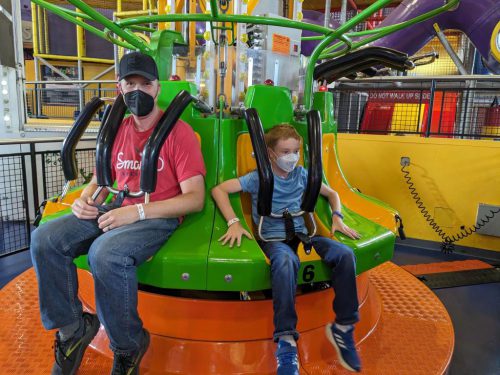

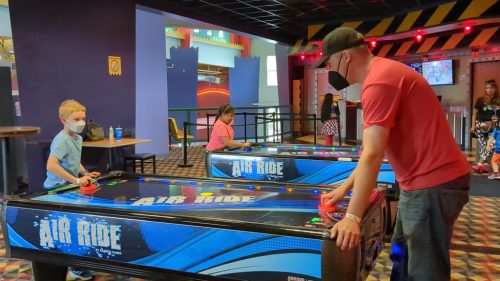
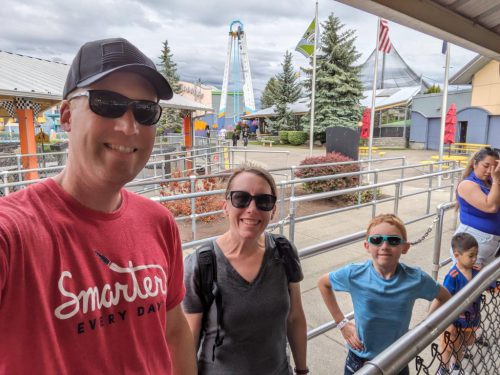
Grayland Beach State Park Camping
Nine months ago, we booked a camping trip to Grayland Beach State Park with Tyla’s family. Booking in mid-June is generally a bit risky in this area, but thankfully we have had a wonderfully dry and warm spring. Even though we were on the coast, we had highs in the low 60s and lows around 50.
Don and the crew brought their camper as usual, but instead of staying in a tent, Tyla, Elijah and I stayed in a yurt! It was the first time we’d rented one and it was convenient. Aside from the benefit of not having to set up or take down a tent, there’s also a lot more space to move around, get dressed, etc. There was also a small electric heater which we used a little bit.
The walk to the beach is quite long (about 2/3 of a mile to the high tide point or over a mile if it’s low tide.) Most of that is over dunes and if you’re carrying some chairs and shovels, it’s a hike. So after doing the hike a time or two, I decided it was time to drive the truck onto the beach. It’s legal in this area, but of course it’s your own fault if you end up getting stuck. We’ve done it once before but the access road I used before was pretty sketchy. Thankfully, this time I found a better access point about a mile down the road and we ended up using that a couple times.
We also took a couple trips about 20 minutes north to the town of Westport. They have a very long jetty up there and we also stopped in shops for ice cream and candy. Our time at the campsite was filled with digging on the beach, cornhole, reading books, and lots of delicious food.
Considering that the whole trip could easily have been rainy and 40 degrees, I’m very thankful for the easy, fun weekend!
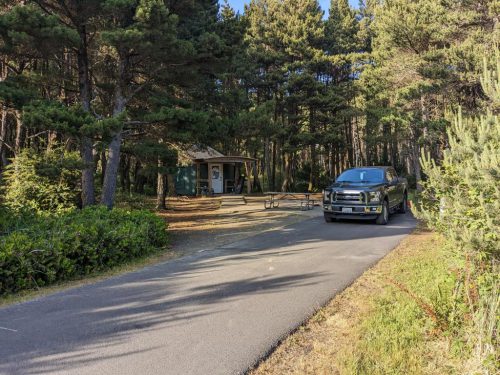

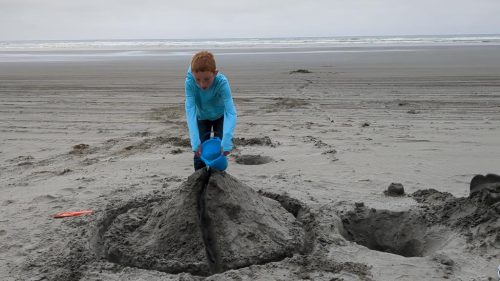

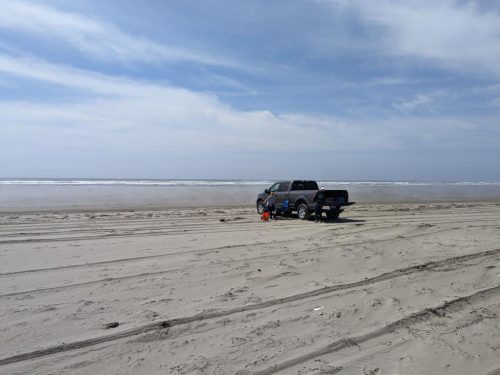

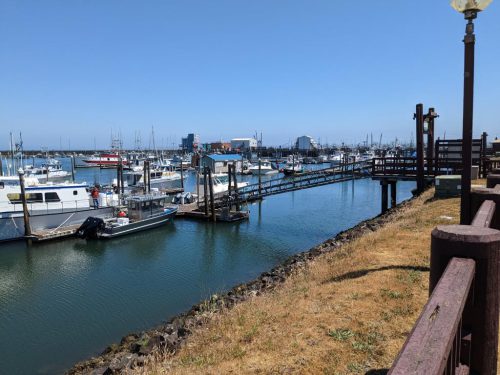
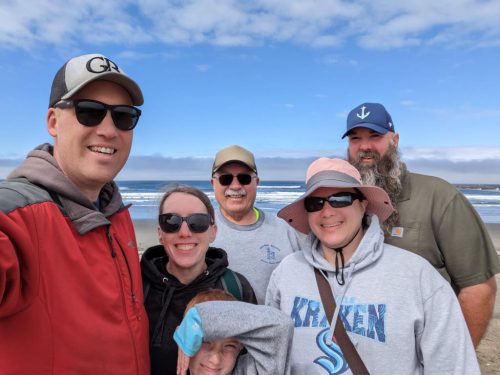
Syncthing

Apps like OneDrive and Dropbox are good at syncing your files to the cloud, but what if your scenario is a little more complicated? I ended up with one such scenario due to my cheapskate reasons for wanting to keep an old Pixel phone for its free Google photos storage.
My old Pixel 4a has lifetime free photo storage on Google Photos. Any photo I upload from that phone is free whether it originated there or not. So that means that I need to take all the photos off of our new phones and push them to the old phone. I also like to keep a full resolution copy of all our photos on our file server. I had a manual way of making this work before, but this past week, I found something that seems to be working a little smoother.
There is an open source app called Syncthing. It’s available for most platforms, and while it’s not as user friendly as other options, it is pretty straightforward and has a lot of knobs for adjustment. The basic setup is this:
Syncthing runs on each of our phones. It’s configured to watch for any camera photos or other image files like screenshots or text message pictures that we save. When we’re connected to WiFi, those files get sent to our file server at home which is also running Syncthing. The file server saves them all to disk and then also sends them out to the old Pixel 4a. The Pixel 4a is also running Syncthing and is setup to receive files from the file server. It writes them to a folder on the phone and then Google Photos sees those new files and uploads them to our Google Photos account. Every file goes new phone to file server to old phone to Google Photos. It’s a lot of movement, but it’s automated.
The only hiccup is that the old Pixel 4a runs two user profiles (one for Tyla and one for me.) So I have to periodically flip back and forth between the profiles to let the syncing happen, but that’s a lot easier than it used to be.
Cedar Butte Hike
After record-breaking cold and wet March and April, May has been incredible with temperatures in the 70s and lots of dry weather. A mid-May hike would normally be “early season” conditions, but this one felt like planning for a summer hike.
The trick to hiking this time of year is that everyone is crammed onto the same hikes. Everything in the mountains is still buried in feet of snow. Any popular hike (Rattlesnake Ledge, Tiger Mountain, Mount Si, etc) is a madhouse. I searched around for a bit and found the Cedar Butte hike.
We arrived at about 8:50am after driving past an already maxed out overflow parking area for Rattlesnake Ledge. Parking at our trailhead was only about a third full. On the way up we only saw two other groups and on the way down we saw about eight. It was great to be able to enjoy the peacefulness of the hike.
The first half of the hike is very flat as it follows the old railroad grade John Wayne Trail. There’s a sign for Cedar Butte that shoots you steeply uphill. It only took us about an hour to reach the peak, so we were back in the car by around 11am. The parking lot was jammed full at that point.
For you history buffs, read about the Boxley Burst which happened right in this area. After trying to create a dam, part of the hillside blew out and wiped a town away in the middle of the night. Thanks to a vigilant watchman, everyone got away to safety just in time, but literally all they had left were the clothes on their back.
We have a busy summer ahead but I’m looking forward to squeezing in more hikes!
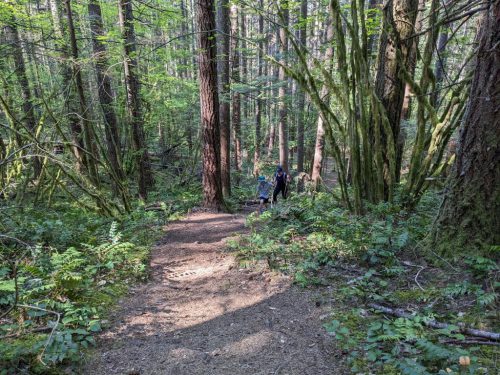

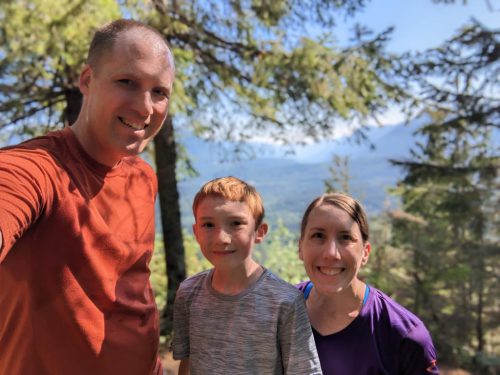
Tesla Model Y 20,000 Mile Review
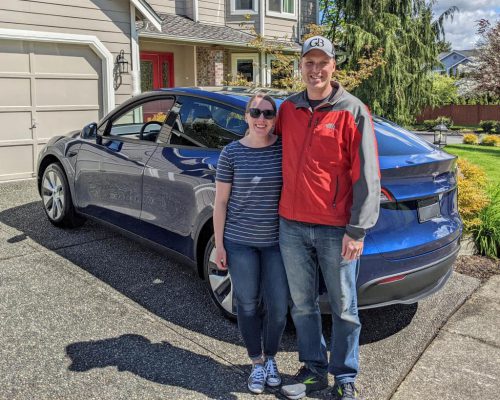
We hit 20,000 miles on our 2022 Tesla Model Y just a few weeks short of the 1-year mark. Let’s take a look at how it’s going so far.
Cost
If you remember my very first post about the car, lifetime cost was a major factor in my purchase of the car. I’ve been interested in electric vehicles for years, but I wasn’t willing to pay extra to drive one. We would likely have replaced our last Ford Escape with another Escape so I used that as a baseline to see if an EV was likely to be cost effective. Even taking a pessimistic view towards EVs, I felt like the Model Y was likely to at least break even with the lifetime cost of the Escape in our scenario, so we went for it. I also used 100,000 miles to define “lifetime” because I knew that with a long enough time range, the EV would almost always win and again, I didn’t want to jump into anything just “hoping for the best.”
Based on the price of the Escape we were looking at an the Model Y we purchased, I needed to save $18,000 over the life of the car. This includes sales taxes and delivery fees and also assumes that we would have been able to get the Escape at MSRP. Since I have access to some special Ford plans through family and work, we hopefully could have gotten it under MSRP, but the average person walking in off the street would struggle to get MSRP.
Let’s break down the various factors in the lifetime cost of the car and see how its going. Buckle in. I have lots of data.
Gas/Electricity
This is the cost difference that usually comes to mind first, and we’re really doing well in this category. My “break even” analysis was done with an estimate of gas prices averaging around $3.50 for the life of a car. (Remember I was being pessimistic about EVs so that’s why I picked a low price.) I have an app running on my machine that pulls gas prices from the 6 closest gas stations and I use the average of those prices as in my what-if analysis. The red arrow in the chart below denotes when we took delivery.
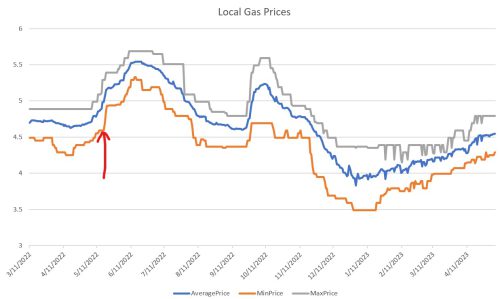
It felt pretty good to be driving a brand new electric vehicle when the average gas price as over $5.50!
Every day, I run a calculation that takes the average gas price and the number of miles we drove that day and estimates what our gas price would have been for that day. Obviously this isn’t quite perfect because we wouldn’t fill up every day, but it’s not going to be very far off and it’s way more accurate than using average gas prices over large chunks of time.
Over the last 20,000 miles we have spent $802.56 on electricity versus an estimated $4041.63 on gas for a savings of $3239.07 or $16.15/100 miles. If that keeps up, we’ll have saved over $16,000 on gas by the time we get to 100,000 miles!
Registration Fees
Washington state charges an extra $150 registration fee for all electric vehicles since they aren’t getting gas taxes. In my area, we also have registration, property, and sales taxes related to light rail buildout. The registration tax is based on their estimated value of your car. This year it cost $939.25 to put license plates on our car! It’s hard to compare this to what the Escape would be since my cost to register keeps going up (despite the car value going down) as new taxes are voted in and I’m not going to recalculate them all. But since about 2/3 of the total fee is related to that light rail tax and since the Escape was about 2/3 the cost of the Model Y, I’d estimate that we’re paying an extra $200/year for that light rail tax plus the $150 extra for having an electric vehicle. So that’s $350/year extra that we pay for the Model Y versus the Escape. Hopefully that will decrease over time as the car depreciates… it will be a race between depreciation and our ability to vote in new taxes.
Service Costs
The only service costs up to this point is a leftover bottle of wiper fluid that I’ve been using. We did have a leaky tire but that was patched by Discount Tire for free. There have been some recalls but they’re all handled via software. We’ve never had this car in for service. Our last Escape cost us $4318 in service over 105,000 miles so I’m expecting we’ll come out ahead there too.
Resale Price
How much will we sell the Model Y for? How much would we have sold the Escape for? This is where the comparison falls apart. When we get to that point, I can makes some guesses based on the current market, but it’s hard to predict going forward. But we tend to keep our cars for 7-10 years and I’ll be surprised if gas cars hold their value over that period. Pure electric cars currently make up about 6% of total auto sales and it’s skyrocketing. I’m sure there will still be a market for gas vehicles in 7-10 years, but it seems like EVs will probably be more common by that point. We’ll see.
Cost Summary
So all in all, I think we’re easily on track to save that $18,000 by the time we hit 100,000 miles. We’ll probably get there purely with gas savings so unless this car proves to be very unreliable and we have a lot of service costs, we should break even or come out ahead.
And yes, it is of course true that this is not the most cost effective way to drive around. Fixing our old car, buying a used car, or choosing a different type of car could all have been ways to save more money. My comparison was explicitly between a new Escape and a new Model Y.
Stats
- 6181 feet – Highest elevation reached when we drove to Sunrise Visitor Center on Mt. Rainier. The battery charged 4% on the drive down. We drove 57 minutes before getting back to the same power we departed with.
- 292 miles – Longest road trip. We drove to the Alsea, OR area.
- 263 Watt-hours per mile consumed – A single gallon of gasoline contains 33,700 watt-hours of energy so this is the same as 128 mpg.
- 99% – Charges (by count) that took place at home
- 96% – Charges (by kWh) that took place at home
- $77 – Average additional month cost for electricity (for about 1650 miles/month)
- 24% – Energy lost to charging inefficiencies (heat, etc) and drain while sitting (running the computers, preconditioning the interior, etc.) My cost numbers above include the cost of all these non-driving uses.
- 20 – Software updates. These have delivered many new features including Disney+, additional games, and the ability to make the car fart from my phone.
- 18 – Counties visited (map)
- 16 minutes – Average length of charging stops on road trips
- 14% – Lowest usable battery reached. This equates to about 45 miles of range before hitting zero and there’s usually another ~20 miles available after that.
- 6.89 MWh – Total energy consumed which is enough to power the average home in this area for about 6 months.
- 4.9 metric tons – CO2 emissions avoided. This is equivalent to about 5.9 acres of forest for one year.
- 1 – Non-Tesla service center visits. (I had a leak repaired by Discount Tire.)
- 0 – Service center visits
- 0 – Mobile service visits
- 0 – Number of times battery died before reaching a charger
- 0 – Number of brake services or oil changes
- 0 – Number of times Autopilot killed me
(Thanks to user jonjiv on Reddit for making a similar post that gave me this idea.)
Most of the data above comes from TeslaMate. I’ve been running that data collection software from the first day we got it. The list of stats above is just the beginning. I could go on for a very long time with all the random stats and charts!
Experience
If we’re just going to break even, is it worth it? Absolutely! This car is a great fit for us. Here are some of my favorite things other than saving money:
- Charging at home is so convenient. I think this is a major point that many prospective buyers miss. Sure, stopping at gas station is faster than stopping at a charger, but you know what’s stopping at a gas station? Charging while you sleep! We plug in every night and in the morning we’re full again.
- It’s fun to drive. We have the slowest Tesla that they make and that means it goes from 0 to 60 in only 4.7 seconds. The instant torque is quite an experience and I can see why people burn through their first set of tires quickly.
- Getting a new car always feels good because you get rid of all the problems you knew your old car had. Our Escape was always dripping oil and needed a turbo replacement. I love walking into the garage and not smelling anything or having any mystery drips coming out of the engine bay.
- The charging network is incredible. We’ve never seen a Tesla charger that is out of service. No other charging network comes close and if you’re in the market for an EV, I think this should be a major decision point for you. I feel confident going anywhere in the Tesla because I know I’ll always get a charge easily. I would be extremely hesitant to plan a road trip on another charging network.
- In contrast to the point above, I’ll also mention that the charging network isn’t as important as it’s made out to be. “I can’t buy an electric vehicle because we don’t have many chargers around my house.” The charging infrastructure around your house is nearly irrelevant assuming you can charge at home. The only time we need supercharging is when we’re far from home on a road trip.
- The Autopilot feature is incredible. I wrote a full post about it, but in short, it’s still a feature that I use almost every time I drive it. It works everywhere, but I generally use it on the highway when I’m not doing a lot of lane switching. While I know that I’m still responsible for the vehicle, it’s nice to have a robot doing most of the work. I feel much less tired after long drives. You don’t realize how much energy it takes just to stay in your lane until you go an hour or two without doing it!
- One of the best summaries I can give of the car is that even after a year, I still walk into the garage and smile. I still look forward to driving it.
The car gets an “A”, but there is always room for improvement.
- I don’t like how long it takes the car to fall asleep. It’s the difference between using a couple hundred watts versus using only a few watts. Once the car is asleep, using the app wakes it back up, even if you just want to check your charge level. Thankfully I run TeslaMate so I can see basic info about the car without waking it up, but I don’t know why this isn’t built into the default software or why it sometimes takes a few hours for the car to fall asleep. In terms of actual money, it hardly matters, but I’m obviously interested in overall efficiency so it bugs me.
- For the most part, I’m ok with almost all the controls being done through the screen, but I wish there were physical controls for the windshield wipers. About a week ago they added the ability to remap one of the steering wheel buttons to control the wipers but it’s still a combo button press to do something simple.
- The battery does degrade over time. Tesla says that batteries lose about 5% in the first 25,000 miles on their way to losing 12% over the first 200,000 miles. TeslaMate keeps track of that data too (of course) and our car is at about 2.5% loss. I knew this before I bought it and it doesn’t impact us at all. I think it’s mostly a matter just having confidence that our battery will follow that curve and not die prematurely.
- The cruise control is a “Traffic Aware Cruise Control.” Most of the time this is great. It means that I set a maximum speed that I’m willing to go and the car will go that speed or follow the car in front at a specified distance. It automatically sets to be x mph above the speed limit and knows when the speed limits changes. BUT, it’s not perfect. Once every few thousand miles, it does brake when I’m not expecting it to and when I can’t figure out a reason for it to brake. I still use it all the time, but this could be better.
Conclusion
If we were making the choice again today but with the added knowledge we’ve gained, it would be a no-brainer to buy it again. Prices have come down since we bought it and there are federal incentives that may or may not apply in various scenarios. I’m pretty confident that this will end up saving us money versus the Escape in the long run, or if not, it will be so close that I’m happy to have paid a few extra bucks for all the convenience and fun that it offers.
EVs are here to stay, but it will take a long time for all use cases to be met by them. I’m just happy that our use case has been nailed!
Eureka Filming Site Visit
I’ve been burning through the Eureka (2006-2012) TV show episodes on Amazon Prime. I’m a Stargate fan and this was recommended to me as something with a similar vibe (and a lot of crossover actors.) Like Stargate, a lot of the filming happened in the Vancouver, BC area.
I was curious where the downtown Eureka scenes were filmed so over many episodes, I carefully looked for clues and searched and searched and searched around on Google Street View until I finally found a couple blocks on Wellington Ave in Chilliwack, BC which looked similar. (Shortly after that, I found this website which lists out all the filming locations for many different shows. Derp.) That’s only a couple hours from our house and it seemed like it could be a fun family adventure day so I looked up a few other possible activities and we set off.

Our first stop was the filming location and even though it has been 10 years, I was happy to see how much it felt like walking through Eureka. It wasn’t quite the same vibe I had walking through Radiator Springs at Disneyland, but it was similar.

With my own nerdery satisfied, we set off to find some food at Cookies Grill. I don’t remember how I stumbled on this place (Yelp?) but I suspected it would be a winner since Tyla and Elijah love breakfast and Cookies serves breakfast for lunch. It lived up to their expectations and they honestly talk about driving all the way back there to eat again some time.
While we were walking around Eureka, there were a few other people there looking in the shops, etc. One of the couples seemed like maybe they were Eureka fans too but that seemed unlikely and I wasn’t about to start that weird conversation. When we drove ~10 minutes to get to Cookies Grill in a random strip mall area, we got out of the car and the same couple was in the parking lot! Weird things happen in Eureka.
It was still raining but we went for a hike anyway to see Bridal Veil Falls. The path is almost smooth enough for a wheelchair (except for a couple stairs) and it’s only ~5-10 minutes long, but it’s steep. The falls are beautiful though and the length of the tiny hike was about perfect for our day.
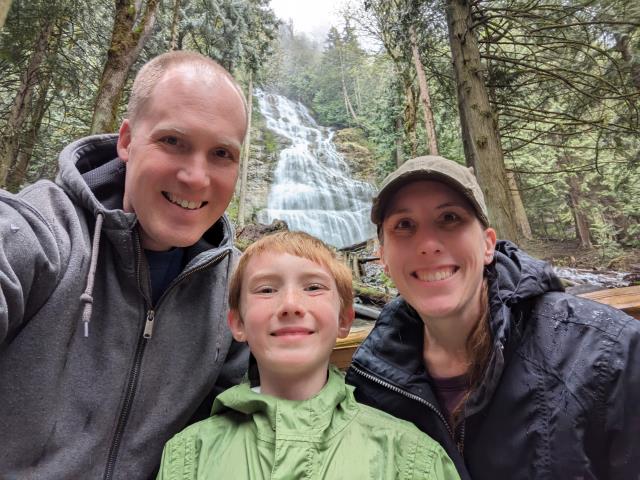
From there we stopped for ~10 minutes at the Chilliwack Supercharger on Luckakuck Road and then continued our journey via Lickman Road. As we giggled about the street names, we drove to Chilliwack River Valley Honey where we picked up a few jars of delicious honey. (Before we left home, I verified that we could get back across the border with it.)
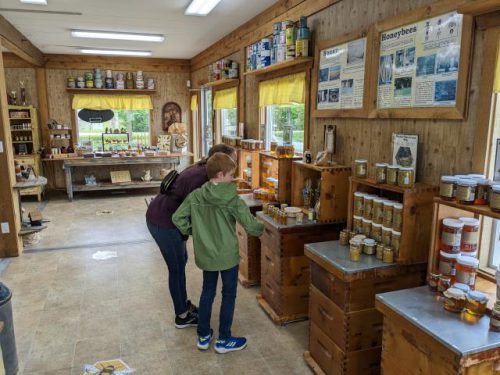
Our border entry into Canada had been quick and while the internet said the return trip would be quick, the line of about a dozen cars was moving very slowly. They were carefully inspecting everyone, searching a lot of cars, and even pulling some cars off to the side for additional inspections. As we approached the booth, I was prepared for a lot of questions, but apparently we are super boring and we were almost waved right on through.
Despite what the border guard must have thought of our story, we loved it! It was a lot of driving for one day, but Elijah had fun going to Canada for the first time that he can remember, and we all enjoyed the random sites. There were quite a few other attractions in Chilliwack that looked interesting (water parks, giant lakes/parks, disc golf, etc.) so who knows, maybe we’ll be back!

